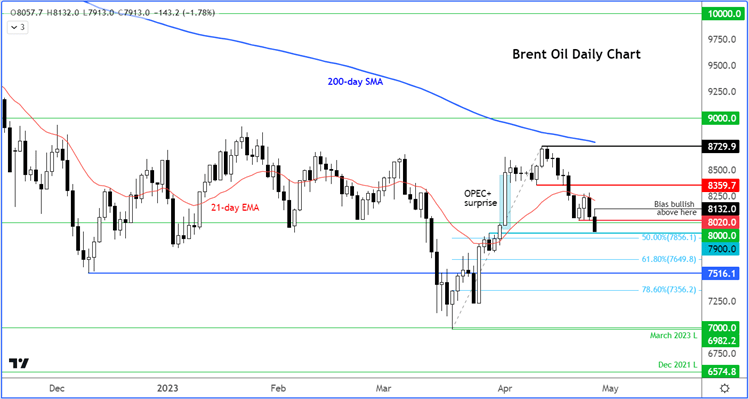
Brent oil plunged below $80 for the first time in since the end of March, while WTI also hit fresh lows for the month beneath $76. Both oil contracts have therefore finally closed their price gaps that were formed at the start of the month when the OPEC+ agreed to cut oil production significantly in a surprise decision. With the gaps now closed, can oil stage a big comeback? I wouldn’t bet against, even if recession concerns might be on the rise. While I am waiting for a technical reversal signal for confirmation, fundamentally my crude oil outlook is bullish.
Why have oil prices fallen?
Crude oil has come under pressure due to a handful of reasons in recent week.
- First and foremost, it is concerns about recession and therefore weaker demand causing investors to largely ignore the upside risks stemming from the OPEC+ deal.
- Secondly, may traders have undoubtedly booked profit on their long positions after prices formed those big breakaway gaps at the start of the month. By squaring their positions, they effectively sold oil at the market, thus creating downward pressure.
- Thirdly, a lot of would-be buyers on the futures markets have probably stayed on the side lines, waiting for the gaps to close, as they often do. So now that this condition has been met, watch out for signs of a bullish reversal.
- Finally, it looks like Russia might not be complying with the OPEC+ cuts completely. An average of 3.4 million barrels of oil per day were flowing from Russian ports, unchanged after the previous week’s recovery, according to tanker-tracking data compiled by Bloomberg.
Crude oil outlook: Can prices recover?
Well, the fact that Russia is continuing to sell high volumes of oil means demand remains suggesting that the crude oil outlook is not as bearish as recent price action might suggest. Some of Russia’s large consumers include China, India and Turkey. But Russia is obviously selling its oil cheaper because of the US-led sanctions. However, the Russian government has promised to comply with the OPEC cuts. Reuters has cited an unnamed Russian government official as saying that the country’s crude output this year is on course to be about 9.6 million barrels per. Assuming there is not going to be any major compliance issues with the output cuts, this should keep a floor under prices.
Granted, there may be genuine concerns about demand due, above all, to the impact of high interest rates and inflation hitting consumer and business spending.
But it is the supply side of the equation that often matters is when it comes to oil prices. On this front:
- US crude oil stocks have been falling in recent weeks, suggesting higher demand from refineries. This is usually supportive of prices. Apparently, oil stocks fell by more than 6 million barrels in the week ended April 21, according to the American Petroleum Institute. Official inventories data is due later in the session.
- Following the OPEC’s surprise decision at the start of the month to cut oil production unexpectedly by nearly 1.7 million barrels per day, this is going to start impacting the physical market soon. Assuming there won’t be any demand-side shocks in the meantime, and supply compliance remains near 100% among the OPEC members, the market should tighten significantly, providing good support behind oil prices.
- Non-OPEC supply will increase over time and reach pre-covid levels. However, the negative of this on oil prices will be a longer-term issue. Last year the US produced an average of 11.9 million barrels of oil per day, just below the record average of 12.3 million bpd set in 2019.
US dollar weakness also boosting crude oil outlook
Crude oil has may also find support because of the ongoing weakness in US dollar. The EUR/USD has surged to near 1.11 handle, while the GBP/USD has risen to 1.25. The Japanese yen has strengthened, causing the USD/JPY to dip near 133.00. The dollar index sits near its yearly lows and remains on track to potentially head down to 100.00. This is all because of optimism interest rate hikes are coming to an end, thanks to falling global inflation.
What’s happening in financial markets today?
WTI has yet to fully close that OPEC gap created a few weeks ago. So there still remains hope for the bulls that oil might be heading higher.
The dollar index remains near this year’s low as the yen joins the European currencies in exerting pressure on the dollar. The greenback is holding better against commodity dollars, suggesting we are in a risk off environment. Indeed, global indices sold off yesterday and are struggling to find much love today, albeit stronger earnings from Microsoft and Alphabet have helped to support Nasdaq futures slightly.
Brent technical analysis: Bulls awaiting reversal signs
Brent’s next key support level is around $79, which was resistance in the days leading to the OPEC’s surprise move. It is possible that Brent might turn around from there. But given the strong bearish momentum, let’s wait for a bullish reversal sign to emerge before turning bullish on oil, rather than pre-empting a reversal. A potential move back above the $80 handle today would certainly boost the crude oil outlook in the short-term, if prices were to stage a recovery now.

How to trade with City Index
You can trade with City Index by following these four easy steps:
-
Open an account, or log in if you’re already a customer
• Open an account in the UK
• Open an account in Australia
• Open an account in Singapore
- Search for the company you want to trade in our award-winning platform
- Choose your position and size, and your stop and limit levels
- Place the trade










